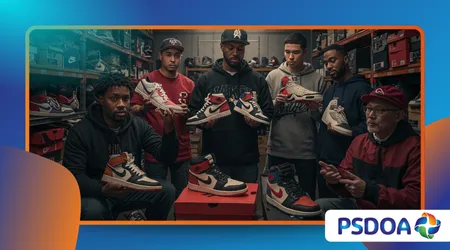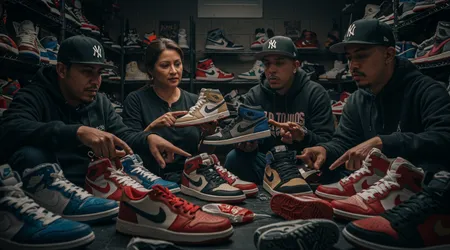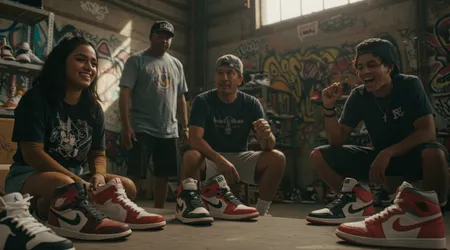The Secret Language of Sneakerhead Collectors

The Secret Language of Sneakerhead Collectors pulses with life, a vibrant code binding a global subculture obsessed with sneakers.
Anúncios
This intricate dialect woven from slang, rituals, and unwritten rules defines sneakerheads, a community where shoes transcend function to become art, status, and identity.
In 2025, sneaker culture thrives, fueled by social media, limited-edition drops, and a relentless pursuit of exclusivity.
This blog dives deep into the lexicon, symbols, and practices that shape this microculture, revealing why sneakers are more than footwear they’re a lifestyle.
Why does this language matter? It’s the heartbeat of a subculture that spans continents, uniting enthusiasts through shared passion and insider knowledge.
Anúncios
From New York’s street corners to Tokyo’s sneaker boutiques, the Secret Language of Sneakerhead Collectors evolves daily, driven by creativity and competition.
This exploration uncovers the terms, rituals, and values that make sneakerheads a unique tribe, offering a window into their world for newcomers and veterans alike.
The Lexicon: Words That Define the Culture
Sneakerheads speak a dialect rich with terms that outsiders might miss. “Deadstock” means unworn, pristine sneakers, often stored as collector’s items. “Hypebeast” describes those chasing trends, while “OG” honors original designs.
These words carry weight, signaling authenticity or clout. For example, calling a pair “DS” (deadstock) in a trade can boost its value instantly.
++ Gorpcore: How Hiking Gear Became a Fashion Statement
This lexicon isn’t static it grows with each release. Terms like “cop” (to buy) or “L” (loss, failing to secure a drop) shape online banter.
Sneakerheads use these to navigate platforms like StockX, where bids and asks mimic stock trading. The language fosters belonging, separating true enthusiasts from casual buyers.
In 2025, slang evolves faster than ever, fueled by X and TikTok. New terms like “flex tax” (the social cost of showing off) emerge, reflecting the community’s wit. This dynamic vocabulary keeps the culture exclusive, a code only the initiated fully grasp.

Rituals of the Drop: The Hunt for Exclusivity
The Secret Language of Sneakerhead Collectors shines brightest during sneaker drops. Limited releases, like Nike’s Air Jordan collabs, spark frenzied rituals.
Sneakerheads camp online, refreshing apps like SNKRS, or queue at stores, chasing coveted pairs. The term “copped” signals victory; “bricked” means failure.
These rituals are strategic. Bots automated software scoop up stock, frustrating manual buyers. Sneakerheads counter with “proxies” (alternate IP addresses) to bypass restrictions.
The thrill lies in outsmarting the system, a game where knowledge of release times and raffle tactics is currency.
Also read: Dark Academia: Where Aesthetic Meets Intellectual Rebellion
Social media amplifies this hunt. X posts with hashtags like #SneakerDrops share tips in real-time. For instance, a 2024 Complex report noted 70% of sneakerheads use bots, highlighting tech’s role.
Drops aren’t just purchases they’re cultural events, binding the community through shared adrenaline.
The stakes are high. A missed drop can mean losing a grail a sneaker so rare it’s mythical. Sneakerheads trade stories of near-misses, like missing a Yeezy drop by seconds. These tales, shared on forums, reinforce the subculture’s camaraderie and resilience.
Symbols and Status: Sneakers as Social Currency
Sneakers are more than fashion; they’re symbols of status. The Secret Language of Sneakerhead Collectors includes visual cues specific models signal wealth or taste.
A pair of Off-White Nikes screams exclusivity, while rare Jordans denote heritage. Wearing “heat” (high-value sneakers) earns respect.
This symbolism extends to customization. Sneakerheads commission artists for bespoke designs, like hand-painted Air Force 1s.
These one-offs, shared on Instagram, elevate status. The term “1 of 1” (unique) is a badge of honor, showcasing individuality.
Read more: Inside the World of Cottagecore: Escapism in the Digital Age
Condition matters too. Scuffs or creases can tank a sneaker’s value, hence the obsession with “sneaker shields” (protective inserts).
Collectors display their pairs in glass cases, treating them like art. This reverence reflects sneakers’ role as cultural artifacts, not just shoes.
The sneaker market reflects this. StockX reported $6 billion in sales in 2024, with rare sneakers fetching thousands.
A single pair, like the 1985 Air Jordan 1s, sold for $560,000 at auction. Such figures underscore sneakers’ transformation into investment assets, rivaling fine art.
| Sneaker Model | Release Year | Average Resale Price (2024) | Cultural Significance |
|---|---|---|---|
| Air Jordan 1 | 1985 | $2,500 – $560,000 | Iconic, tied to Michael Jordan’s legacy |
| Yeezy Boost 350 | 2015 | $400 – $1,200 | Kanye West’s influence, mass appeal |
| Off-White Nike | 2017 | $800 – $3,000 | High-fashion crossover, exclusivity |
| Travis Scott SB | 2020 | $1,000 – $5,000 | Celebrity collab, streetwear hype |
Community and Connection: Bonds Beyond the Shoes
The Secret Language of Sneakerhead Collectors fosters deep connections. Sneakerheads gather at events like Sneaker Con, trading shoes and stories.
These meetups, buzzing with slang like “NT” (new with tags), feel like secret societies. Online, Discord servers and X groups hum with debates over “best drops.”
This community thrives on storytelling. Take Jake, a New York sneakerhead who traded his PlayStation for a pair of 2011 Jordan 11 Concords. His story, shared on X, went viral, earning him clout. Such narratives bind sneakerheads, turning transactions into folklore.
Authenticity drives these bonds. “Calling out fakes” is a ritual spotting counterfeit sneakers protects the culture’s integrity.
Apps like CheckCheck help verify authenticity, but seasoned collectors rely on instinct, honed by years of studying stitching and logos.
Sneakerheads also mentor newcomers. Veterans share “plug” tips trusted sellers or raffle hacks on platforms like Reddit. This generosity strengthens the subculture, ensuring its language and values endure across generations.
The Global Stage: Sneaker Culture’s Worldwide Reach
Sneaker culture transcends borders, with the Secret Language of Sneakerhead Collectors adapting to local flavors.
In Japan, sneakerheads chase exclusive Bape collabs, using terms like “kicks” with reverence. In London, “creps” (slang for sneakers) dominates street talk. Each region adds unique slang, enriching the global lexicon.
Social media bridges these scenes. TikTok challenges, like styling rare Nikes, go viral, spreading the language.
A Tokyo collector might post a “fit check” (outfit showcase), inspiring a Miami sneakerhead to respond. This exchange fuels innovation, keeping the culture dynamic.
Economic disparities shape access. In wealthier nations, sneakerheads splurge on resales, while in emerging markets, customizations thrive due to cost.
For example, Brazilian artists repurpose old Nikes into vibrant designs, earning global followers. This adaptability showcases the culture’s resilience.
The global sneaker market hit $92 billion in 2024, per Statista, with Asia leading growth. Sneakerheads worldwide share the same passion, their language evolving to reflect local identities while maintaining a universal core.
The Future of Sneakerhead Language: Evolution and Challenges

As sneaker culture grows, the Secret Language of Sneakerhead Collectors faces new frontiers. Virtual sneakers in the metaverse, like Nike’s RTFKT designs, introduce terms like “digital drop.”
Collectors now trade NFTs, blending physical and virtual hype. This shift challenges traditionalists who prize tangible shoes.
Sustainability is another frontier. Sneakerheads debate “eco-kicks,” shoes made from recycled materials. Brands like Adidas push sustainable lines, sparking terms like “green flex” for eco-conscious style. Yet, some collectors resist, valuing rarity over ethics.
Corporate influence looms large. Nike and Adidas dominate, shaping drops and slang.
Smaller brands struggle, but sneakerheads champion them, coining terms like “underdog heat” for niche releases. This tension keeps the language vibrant, balancing mainstream and underground voices.
The rise of AI bots poses a threat. Advanced bots snag drops faster, frustrating collectors. New slang, like “bot wars,” reflects this struggle.
Sneakerheads adapt, using encrypted chats to share strategies, preserving their culture’s exclusivity.
Conclusion: A Language That Lives and Breathes
The Secret Language of Sneakerhead Collectors is a living, breathing code, weaving together passion, creativity, and community.
It’s a dialect of devotion, where every term, ritual, and symbol tells a story. From the thrill of a drop to the pride of a rare pair, this language defines a subculture that’s global yet intimate.
As sneakers evolve blending physical, digital, and sustainable realms so does the lexicon, proving its resilience.
Isn’t it remarkable how a pair of shoes can spark such a vivid, universal dialogue? Sneakerheads don’t just collect they communicate, innovate, and connect.
This language isn’t just words; it’s a cultural pulse, beating strong in 2025 and beyond. Join the conversation, learn the code, and step into a world where sneakers speak louder than words.
FAQ: Frequently Asked Questions
What is the “Secret Language of Sneakerhead Collectors”?
It’s the unique slang, rituals, and symbols sneakerheads use to communicate their passion, status, and community ties, like “deadstock” or “copped.”
How do sneakerheads learn this language?
Through immersion engaging in drops, joining forums, or attending events like Sneaker Con. Social media platforms like X accelerate learning.
Why are limited-edition drops so important?
Drops fuel exclusivity, driving competition and community bonding. They’re cultural events where securing a pair earns bragging rights.
How does technology impact sneaker culture?
Bots and apps like StockX streamline trading but frustrate manual buyers, sparking new slang like “bot wars” and tech-driven strategies.
Is sneaker culture inclusive?
It’s global and diverse, but economic barriers and bot dominance can limit access. Local customs and mentorship help bridge gaps.
